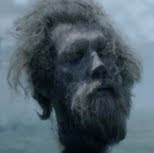Captain Travers Looses His Head to Te Kooti
The Tuhoe tribes were a fierce warlike people whose proud boast “'Tuhoe moumou taonga, moumou tangata ki te Po” (“Tuhoe, the destroyer of earth’s treasures and the master of mankind unto death”) resulted in the bones of their warriors finding a resting place on many battlefields, while their heavily forested and rugged mountainous fastness in the Urewera saved them from them from disastrous invasion for centuries.
However, after they sheltered Te Kooti and his Ringatu followers, the Tuhoe experienced the full vengance of the Crown in 1869 - their crops were burnt, their stock killed and their villages destroyed. Even worse, much of their land was later confiscated.
As part of this scorched earth policy government troops attacked the strongly fortified pa of Tatahoata, at Ruatahua, May 1869. During the engagement, Captain Travers strode up and down directing the troops. On being advised by experienced bush-fighters to make himself less conspicuous, he remarked: “A British officer never takes cover.” (Shades of Von Tempsky and Admirial Lord Nelson here). Moments later he was shot dead by a heavily tattooed Maori - who in turn was immediately killed himself.
(See blog post below: Tattooed Hahuhau Warrior Killed)
After the destruction of the pa Captain Travers and the other seven Government troops killed in the engagement were all buried in shallow graves on the site, then the survivors departed.
Shortly afterwards Te Kooti and his followers arrived. Following his usual obeyance of Biblical injunctions Te Kooti ordered that the enemy bodies be dug up and left in the open as food for hawks and wild pigs. Binney* (p130 ) says: “The revenge Te Kooti exacted was based in the scriptural texts from the world of the Israelites in their suffering......The dead were left unburied, their flesh to be given to the beasts of the field.”
Deuteronomy 28:26:
“And thy carcase shall be meat unto all fowls of the air, and unto the beasts of the earth...”
Shortly afterwards Te Kooti and his followers arrived. Following his usual obeyance of Biblical injunctions Te Kooti ordered that the enemy bodies be dug up and left in the open as food for hawks and wild pigs. Binney* (p130 ) says: “The revenge Te Kooti exacted was based in the scriptural texts from the world of the Israelites in their suffering......The dead were left unburied, their flesh to be given to the beasts of the field.”
Deuteronomy 28:26:
“And thy carcase shall be meat unto all fowls of the air, and unto the beasts of the earth...”
Two years later (after Te Kooti had been expelled by Tuhoe) Captain Gilbert Mair and Captain Preece returned to the area to recover the scattered remains of their comrades. Following Maori custom, the heads had been impaled as victorious displays on palisade posts, and remained there.
Mair recognized the rotted trophy skull of his fellow officer Captain Travers by his gold teeth. This and other body parts of the fallen were collected, then reverently buried in a deep common grave - with the former Tuhoe opponents of the Crown joining in the formal military service. Two poplars were planted over the grave.
In 1935 the Whakatane Historical Society created a soldier’s cemetery near the spot and erected memorial headstones to the fallen.
*Judith Binney: "Redemption Songs"




Comments
Post a Comment